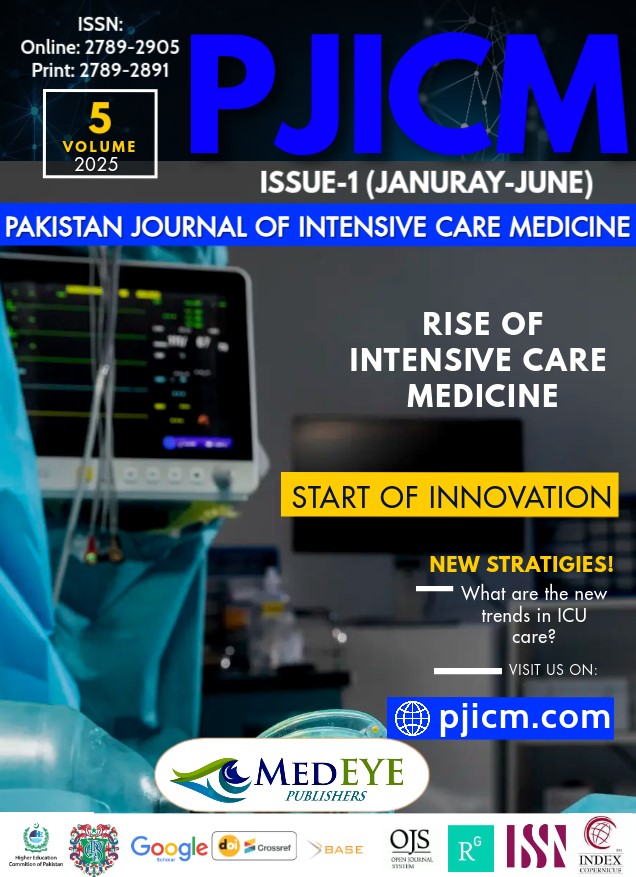DIAGNOSTIC ACCURACY OF ELASTOGRAPHY IN PREDICTING MALIGNANT THYROID TUMOR WHILE TAKING HISTOPATHOLOGY AS GOLD STANDARD IN PATIENTS PRESENTING TO LADY READING HOSPITAL PESHAWAR
DOI:
https://doi.org/10.54112/pjicm.v5i01.50Keywords:
Strain Ultrasound Elastography, Thyroid Nodule, Malignancy, Histopathology, Diagnostic Accuracy, Lady Reading HospitalAbstract
Background: Thyroid nodules are a common clinical finding, with a subset harboring malignancy. Strain elastography has emerged as a promising non-invasive imaging modality for assessing thyroid nodules. However, histopathology remains the gold standard for a definitive diagnosis. Evaluating the diagnostic accuracy of strain elastography can aid in improving preoperative assessment and reducing unnecessary biopsies. Objective: To assess the diagnostic accuracy of strain elastography in detecting malignant thyroid nodules, using histopathology as the gold standard. Study Design: Cross-sectional validation study. Setting: Radiology Department, Lady Reading Hospital, Peshawar. Duration of Study: 27 August 2023 to 27 February 2024. Methods: A total of 110 patients aged 18 to 70 years with palpable thyroid nodules were included using consecutive sampling. Patients with prior thyroid surgery, chronic kidney disease, or pregnancy were excluded. Strain elastography was performed using a 7.5 MHz linear probe, with malignancy suspected based on features such as microcalcifications and irregular borders. Histopathological examination served as the reference standard. Sensitivity, specificity, positive predictive value (PPV), negative predictive value (NPV), and diagnostic accuracy were calculated using a 2×2 contingency table. Statistical analysis was performed using SPSS version 21. Results: The study population had a mean age of 41.22 ± 15.08 years and a mean body mass index (BMI) of 25.75 ± 1.80 kg/m². Female patients comprised 54.5% of the cohort, while males accounted for 45.5%. Strain elastography identified malignancy in 53 patients (48.2%), whereas histopathology confirmed malignancy in 51 patients (46.4%). Among elastography-positive cases, 45 were true positives, and 8 were false positives. Among elastography-negative cases, 51 were true negatives, and 6 were false negatives. The diagnostic performance of strain elastography was as follows: Sensitivity: 88.24%, Specificity: 86.44%, Positive Predictive Value (PPV): 84.91%, Negative Predictive Value (NPV): 89.47%, Diagnostic Accuracy: 87.27%, Conclusion: Strain ultrasound elastography demonstrated high diagnostic accuracy in identifying malignant thyroid nodules, making it a reliable, non-invasive tool for clinical decision-making. Its integration into routine thyroid nodule assessment can enhance early detection while reducing unnecessary biopsies. Future research should focus on incorporating quantitative elastography techniques to refine diagnostic precision further.
References
Haugen BR, Alexander EK, Bible KC, Doherty GM, Mandel SJ, Nikiforov YE, et al. 2015 American Thyroid Association Management Guidelines for Adult Patients with Thyroid Nodules and Differentiated Thyroid Cancer: The American Thyroid Association Guidelines Task Force on Thyroid Nodules and Differentiated Thyroid Cancer. Thyroid. 2016;26(1):1-13.
Pemayun TG. Current Diagnosis and Management of Thyroid Nodules. Acta Med Indones. 2016;48(3):247-57.
Bomeli SR, LeBeau SO, Ferris RL. Evaluation of a thyroid nodule. Otolaryngol Clin North Am. 2010;43(2):229-38
Durante C, Costante G, Lucisano G, Bruno R, Meringolo D, Paciaroni A, et al. The natural history of benign thyroid nodules. 2015;313(9):926-35.
Popoveniuc G, Jonklaas J. Thyroid nodules. Med Clin North Am. 2012;96(2):329-49.
Cantisani V, Grazhdani H, Drakonaki E, D’Andrea V, Di Segni M, Kaleshi E, et al. Strain US elastography for the characterization of thyroid nodules: advantages and limitation. Int J Endocrinol. 2015;2015(1):908575.
Menzilcioglu MS, Duymus M, Avcu S. Sonographic elastography of the thyroid gland. Polish J Radiol. 2016;81:152.
Colakoglu B, Yildirim D, Alis D, Ucar G, Samanci C, Ustabasioglu FE, et al. Elastography in distinguishing benign from malignant thyroid nodules. J Clin Imaging Sci. 2016;6(4):1-6.
Asadullah SA, Ajmal A, Shahid A, Qadir A, Khalid A, Qahar A, et al. Validity of Elastography in Differentiating Benign and Malignant Thyroid Nodules, Keeping Histopathology as Gold Standard. Pakistan J Med Health Sci. 2022;16(6):1014-16.
Tian W, Hao S, Gao B, Jiang Y, Zhang S, Guo L, et al. Comparison of diagnostic accuracy of real-time elastography and shear wave elastography in differentiation malignant from benign thyroid nodules. Medicine. 2015;94(52):e2312.
Lacout A, Chevenet C, Thariat J, Figl A, Marcy PY. Qualitative ultrasound elastography assessment of benign thyroid nodules: Patterns and intra-observer acquisition variability. Indian J Radiol Imaging. 2013;23(04):337-41.
Rago T, Santini F, Scutari M, Pinchera A, Vitti P. Elastography: new developments in ultrasound for predicting malignancy in thyroid nodules. J Clin Endocrinol Metab. 2007;92(8):2917-22.
Hong Y, Liu X, Li Z, Zhang X, Chen M, Luo Z. Real-time ultrasound elastography in the differential diagnosis of benign and malignant thyroid nodules. J Ultrasound Med. 2009;28(7):861-7.
Sebag F, Vaillant-Lombard J, Berbis J, Griset V, Henry JF, Petit PA, et al. Shear wave elastography: a new ultrasound imaging mode for the differential diagnosis of benign and malignant thyroid nodules. J Clin Endocrinol Metab. 2010;95(12):5281-8.
Downloads
Published
How to Cite
Issue
Section
License
Copyright (c) 2025 M AHMAD , MI KHAN

This work is licensed under a Creative Commons Attribution-NonCommercial 4.0 International License.












